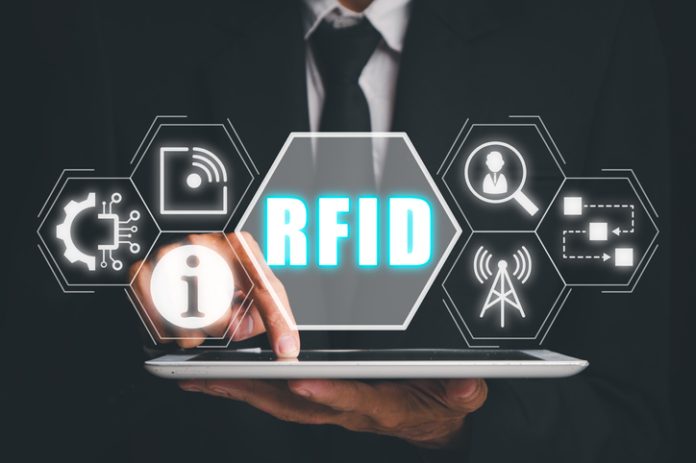In modern business operations, RFID tracking has emerged as a transformative technology, offering a sophisticated solution to the age-old challenge of asset management. This blog aims to dissect the intricacies of RFID tracking, shedding light on its fundamental principles, applications, and the tangible benefits it brings to diverse industries.
At its essence, Radio-Frequency Identification (RFID) is a system designed for precise and efficient tracking of assets. It uses radio waves to transmit data between an RFID tag affixed to an asset and an RFID reader. This communication allows for real-time identification and monitoring, laying the groundwork for a more streamlined and accurate asset management process.
Throughout the following sections, we will delve into the core components of RFID technology, its practical advantages—from improved accuracy in asset identification to cost savings through automation—and the varied applications across sectors such as retail, healthcare, logistics, and manufacturing.
As we unravel the layers of RFID tracking, we aim to provide a comprehensive understanding of its functionality and showcase how it has evolved from a technological concept to a practical and indispensable tool for businesses seeking enhanced control and efficiency in their operations. Let’s explore the world of RFID tracking and its myriad implications for modern enterprise.
What is RFID Technology
RFID, or Radio-Frequency Identification, is a sophisticated technology revolutionizing the landscape of asset tracking and identification. It operates as a digital name tag for assets, where each item is equipped with a small electronic RFID tag containing a unique identifier. This tag communicates with RFID readers through radio waves, enabling rapid and precise identification, even when items are within the packaging. The fundamental components of an RFID system include RFID tags, RFID readers, and a backend database that centrally stores and manages data retrieved from RFID tags. There are two primary types of RFID systems: passive RFID, where tags use energy from the RFID reader, and active RFID, where tags have their own power source for extended-range communication.
Benefits of RFID Tracking
Below are some of the major RFID benefits that you get by implementing RFID tracking software:
1. Precision in Asset Identification
RFID ensures the accurate identification of assets, minimizing errors often associated with manual tracking systems.
2. Efficient Inventory Management
Real-time tracking provided by RFID technology optimizes inventory levels, reducing stock-related issues such as overstocking or stockouts.
3. Continuous Tracking for Real-time Visibility
RFID enables constant monitoring, offering immediate and real-time insights into the location and status of assets.
4. Reduced Human Errors and Manual Labor
Automation through RFID minimizes human errors in data entry and tracking, freeing up resources from labor-intensive processes.
5. Cost Savings through Automation
Streamlined tracking processes and reduced manual labor contribute to overall cost-effectiveness, making RFID a financially sound investment for businesses.
Applications Across Industries
Here are the applications of RFID software or RFID tracking software across different industries:
Retail
In the retail sector, RFID facilitates enhanced supply chain efficiency by streamlining processes and improving overall inventory management. Retailers benefit from increased accuracy, reduced losses, and improved product availability.
Healthcare
RFID ensures precise tracking of medical equipment and supplies in healthcare settings. This technology contributes to seamless patient management, including efficient care delivery and medication tracking.
Logistics
Logistics operations leverage RFID for optimized shipping, tracking, and delivery efficiency. The technology streamlines overall supply chain processes, leading to improved operational performance.
Manufacturing
Manufacturing industries benefit from RFID’s improved production control and minimized downtime. Efficient asset tracking ensures smooth production processes and timely deliveries.
Future Trends in RFID Tracking
As we navigate the rapidly evolving landscape of RFID tracking, several key trends are shaping the future trajectory of this transformative technology.
- Integration with IoT: The integration between RFID and the Internet of Things (IoT) is gaining prominence. This integration extends the capabilities of RFID tracking by providing a more extensive network for data exchange, enabling a more holistic approach to asset management.
- Advancements in Tag Technology: The future holds promises of more advanced RFID tags or RFID scanners featuring enhanced durability, longer battery life (for active RFID tags), and increased data storage capacity. These advancements will contribute to even more precise and versatile asset tracking.
- Edge Computing for Real-time Processing: The adoption of edge computing in RFID systems is on the horizon. This will enable RFID readers to process data locally, reducing latency and enhancing the speed of real-time tracking, which is particularly crucial in fast-paced industries.
- Blockchain Integration for Enhanced Security: As security concerns continue to be a priority, the integration of blockchain technology with RFID tracking is gaining attention. Blockchain can enhance the security and transparency of data in the RFID system, ensuring the integrity of the information collected.
- AI and Machine Learning for Predictive Analytics: The incorporation of artificial intelligence (AI) and machine learning algorithms will enable RFID systems to not only track assets in real-time but also predict patterns and anomalies. This predictive capability will revolutionize decision-making processes in various industries.
Conclusion
RFID tracking stands at the forefront of technological innovation, providing businesses with an indispensable tool for efficient asset management. The benefits of RFID, from precise identification to streamlined inventory processes, are clear and present. As we look to the future, the ongoing integration of RFID with emerging technologies, such as IoT, advancements in tag technology, and the incorporation of edge computing and blockchain, will continue to redefine the landscape of asset tracking.
Businesses across industries are well-advised to embrace these advancements, understanding that RFID tracking is not merely a present solution but an evolving and dynamic tool that will play a pivotal role in tomorrow’s operational efficiency and strategic decision-making. The journey toward optimized asset tracking is ongoing, and RFID technology remains a steadfast companion in this ever-evolving quest for excellence. For more information, get in touch with the professionals today!

































